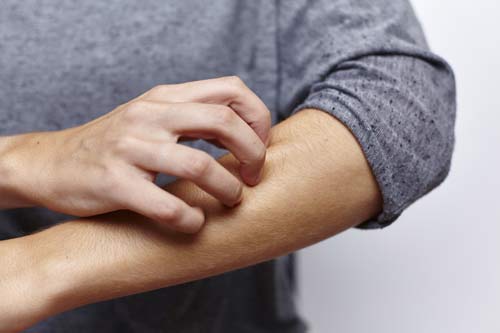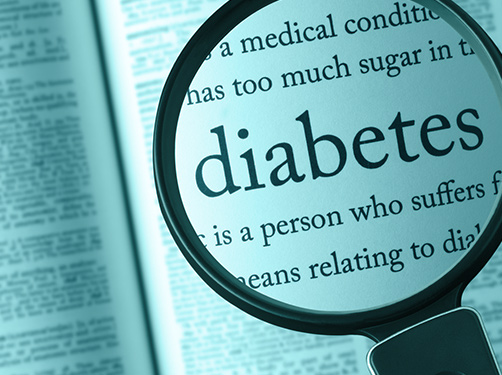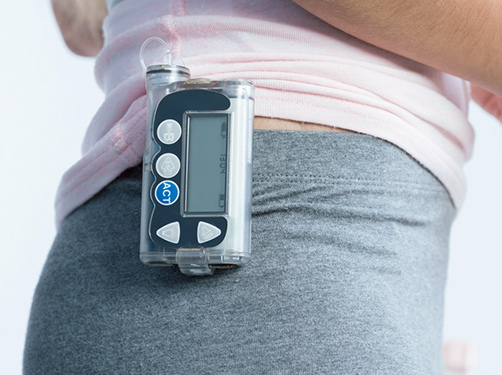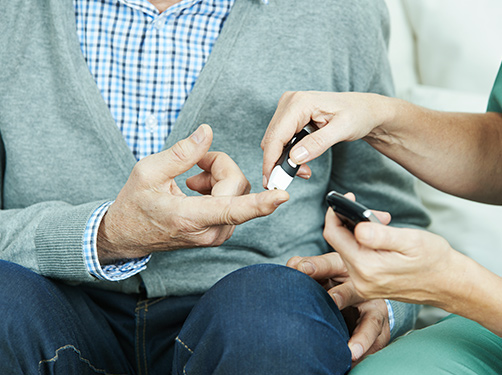Skin diseases associated with diabetes
Scientific support: Prof. Dr. Rüdiger Landgraf
Pathological skin changes can be observed in around 80 percent of people with diabetes. People with type 2 diabetes are affected more often than people with type 1 diabetes.
There are very different skin diseases that can be associated with diabetes. It is not uncommon for the tissues associated with the skin, such as tendons, connective tissue, joints and subcutaneous fatty tissue, to be affected as well.
A major cause of skin diseases associated with diabetes is long-term elevated blood sugar levels. By adjusting blood sugar levels to a range close to normal, skin symptoms can be prevented, their progression slowed or improved.

Contents
- What triggers skin diseases associated with diabetes?
- What increases the risk of skin diseases?
- What causes skin diseases associated with diabetes?
- How can skin diseases associated with diabetes be prevented?
- Skin changes during diabetes therapy
- Skin infections associated with diabetes
- Skin diseases associated with diabetes
- Skin diseases caused by diabetic complications
- How are skin diseases treated?
1. What triggers skin diseases associated with diabetes?
Skin diseases are usually triggered by chronic severe high sugar levels, by antidiabetic medication, e.g., insulin, and other concomitant medications. It is also common for the reasons to remain largely unknown. It has been shown that people with excessive blood sugar levels are more likely to have severe skin changes that those with a more positive metabolic profile.
Good blood sugar management in the long term and early detection can help reduce skin changes, or weaken or even prevent their onset. For this reason, people with diabetes should take care of their skin on a daily basis. If skin changes occur, you should talk to your doctor during the early stages and at regular intervals.
2. What increases the risk of skin diseases?
The principal reason for skin changes is poor blood sugar values. Elevated blood sugar triggers various processes in the body that alter the body's immune response to infection-causing bacteria, viruses, and fungi, leading to complex disorders in the skin, connective tissue, and fat cells in and under the skin. Elevated blood fat and uric acid levels also increase the risk of skin changes.
Good to know:
High blood sugar levels are the greatest risk for skin diseases. For example, excessive blood sugar levels have an unfavorable effect on the function of keratinocytes and fibroblasts. Keratinocytes are cells in the epidermis that produce keratin. Keratin has a water-repellent effect and gives the skin protection, elasticity and stability. Fibroblasts are cells of the connective tissue that also provide resistance and elasticity. If the functions of these cells and thus the barrier function of the skin are disturbed, pathogens (bacteria, viruses, fungi) also find entry ports more easily and can cause an infection.
3. What causes skin diseases associated with diabetes?
The skin diseases that can be associated with diabetes are diverse, and the mechanism of their development is often only rudimentarily known. People with type 2 diabetes are more likely to develop skin infections, while people with type 1 diabetes more often have autoimmune-related changes.
A central role in skin diseases associated with diabetes is played by the so-called “sugaring” of proteins, fats and nucleic acids. The latter include our genetic information. Advanced “sugaring” of these molecules can alter the structure and function of the skin and contribute to the development of damage to blood vessels. Vascular disease and nerve dysfunction disorders(peripheral and autonomic polyneuropathy), along with diabetes-related weakening of the immune system, also make affected individuals susceptible to infection and poor wound healing. The excessively high insulin levels in the blood (hyperinsulinemia) observed in type 2 diabetes due to insulin resistance also influence the proliferation and maturation of keratinocytes. This additionally impairs the skin's barrier function and delays wound healing. Conversely, a relative or absolute lack of insulin – usually accompanied by blood sugar levels that are clearly too high in the long term (as indicated, for example, by high HbA1c values) – can also have a disruptive effect on wound healing.
4. How can skin diseases associated with diabetes be prevented?
Good blood sugar management is essential in the prevention of skin diseases. Good management of blood fat levels, uric acid, and other risk factors in the long-term also prevents complications affecting the skin and contiguous tissue.
Good to know:
The earlier skin changes are detected and treated, the better the chances of improvement or even regression.
The following measures help to prevent skin diseases:
- Try to keep your blood sugar within your individually set target range.
- Keep the skin clean and do not degrease your skin by washing too often with soap.
- Provide the skin with plenty of moisture, for example with a normal skin lotion and/or with creams and ointments containing urea. Avoid baths and showers that are too hot.
- Take good care of your feet and check them every day for sores. Avoid applying lotions, creams or ointments between the toes – except when you have fungal infections in the area between toes and nails. The extra moisture there can promote the growth of fungi.
Contact your diabetes team if you notice any of the following symptoms:
- Noticeable changes in the skin
- Constant itching
- Severe callus formation on the feet
- Wounds (even small ones!) and poor wound healing
- Swelling or irritation at the site of insulin injection
- Injuries to the skin
- Abnormalities in the hands and feet (for example, joint stiffness, trigger fingers, pain when moving the hands or feet, hardening in the palm area)
5. Skin changes during diabetes therapy
All medications, including those used for diabetes therapy, can cause allergic reactions. Possible signs are redness of the skin, wheals and itching. A more extensive rash is also possible. In most cases, however, drug-induced allergic reactions are rather weak and are rarely reported by patients.
Metformin
Although rarely – the diabetes medication metformin can both trigger severe allergic skin reactions and can also be used in the treatment of skin diseases. Studies show particularly positive effects of metformin in acne and acanthosis nigricans, in which the skin turns gray-brown (hyperpigmentation).
Sulfonylureas
When sulfonylureas are taken, the consumption for alcohol or direct son exposure can lead to severe reddening of the skin and dry itching spots. Specialist refer to these as phototoxic reactions. The reason is that the ingredients of sulfonylureas do not mix with alcohol and sunlight. These tends to subside after approx. one hour by themselves.
Insulin
The skin changes described above are also described with the use of insulin. With the highly purified human insulins and insulin analogs that are now – in Germany exclusively – available and the improved administration (application) systems (pens and pumps), these side effects of insulin have become rare. Nevertheless, there can be changes in the subcutaneous fatty tissue at the injection site. Frequent and repeated injections of insulin into a very limited area of the skin may result in both a rather rare local reduction (lipoatrophy) and an increase in subcutaneous fat tissue (lipodystrophy). The processes that lead to these changes are not yet fully known. These can best be prevented by using some kind of system to switch the injection site for every injection.
A insulin delivery catheter, the tip of which is inserted into the subcutaneous tissue, when used as part of a insulin pump therapy, can cause significant irritation of the skin or abscesses. For this reason, people who use a insulin pump should regularly replace the catheter under sterile conditions.
Find out more about insulin therapy here!
Continuous glucose monitoring (CGM)
Blood sugar management using continuous glucose monitoring (CGM) may also cause skin changes. In most cases, these are skin irritations that occur when the adhesive mechanism that fixes the monitoring system is worn for a long time (usually longer than a week). As a result, the skin reddens, itches and becomes more vulnerable. Another cause of the skin changes can be components of the measuring systems, such as certain adhesives (acrylates), which cause itchy skin inflammation in some people.
6. Skin infections associated with diabetes
Infections of the skin are diseases that often affect people with diabetes and are directly correlated to continuously high blood sugar levels. Skin infection can be causes by bacteria or fungi.
Well-known bacterial infections include:
- Erysipelas: This causes red spots on the skin with sharp margins that spread rapidly. It can also cause swollen lymph nodes, fever, chills, and fatigue. Bacteria often accesses the body via small wounds. The most severe cases can result in blisters and skin necrosis.
- Erythrasma: Mostly in skin folds or areas with heavy perspiration (armpits, groin, genital and anal areas, under the female breast), sharply demarcated, scaly areas appear that turn red-brown. Only rarely do people with erythrasma suffer from itching or other problems. In cases with extensive proliferation, it can lead to other types of skin infection.
Well-known fungal infections include:
- Candida infections: Skin changes triggered by the yeast Candida albicans often appear in the mouth, skin folds, hair roots or genital area in men and women. They may itching, weep, or burn. In addition, people with diabetes are more likely to suffer from reddening and swelling of the nail fold (candida paronychia).
- Tinea (dermatophytoses, ringworm): Infections of the skin, hair, and nails caused by filamentous fungi. In people with diabetes, the disease often appears in the feet and between the toes. Open lesions with white margins can be found in these areas. When the nails are affected, this is known as a fungal nail infection and causes the nails to appear brown and dry (onychomycosis).
7. Skin diseases associated with diabetes
Even though diabetes is not the cause of the following skin diseases, many disease often accompany cases if diabetes:
Pseudocanthosis nigricans
This refers to a group of different forms of disease characterized by gray-brown lesions on the skin with a velvet-like surface and unclear margins. How the develop is uncertain. The neck region is usually affected first, following by the armpits, the bends of the joints, or the groin area. Few people with diabetes experience subjective discomfort due to these skin changes. Frequently, those affected are resistant to insulin (insulin resistance).
Diabetic sclerederma
This term refers to a number of changes to the connective tissue of the skin and underlying structures. This disease results from the “sugaring” of proteins (the formation of “Advanced Glycosilation End” (AGE) products) in the skin and the underlying structures (connective tissue, tendons, joints). This causes changes to the arrangement and cross-linking of the collagen fibers. This results in reduced elasticity of the skin and joints (known as limited joint mobility (LJM)). It can lead to numerous, at times painful, conditions affecting, for example, the hands, feet, and shoulders.
Hands:
- Gradual thickening and tightening of tissue under the skin in the hand (Dupuytren's contracture)
- Finger and joint stiffness (cheiroarthropathy or diabetic stiff hand syndrome)
- Trigger finger
- Onset of carpal tunnel syndrome caused by pressure on the median nerve at the wrist. Because the impulse from this no longer reach the hand, motor skill and sensitivity disorders develop in the thumb, index, and middle fingers.
These changes are also found in liver disease, smokers with concomitant alcohol consumption, and people with renal insufficiency with or without diabetes. Compared to women, men are 5 to 10 times more likely to be affected.
Feet: Disorders of mobility in the ankle and toe joints with the risk of abnormal joint loading and injuries in terms of plantar fibromatosis (Ledderhose's disease). This is accompanied by lumps and hardenings on the sole of the foot.
Shoulders: Severe painful limitation of movement affecting the shoulder joint (frozen shoulder)
Xanthoma
These nodular fatty deposits can develop under the skin as a result of diabetes-associated fat metabolism disorder. They are orange-yellow in color and harmless.
Itching
Around one-third of all people with diabetes have dry and itchy skin. The reason is dysfunction of the sweat and sebaceous glands. Scratching usually causes the itching to become worse. Scratch wounds can also easily become infected with other pathogens.
Necrobiosis lipoidica
The skin lesions are often ring-shaped, reddish or brown in color. The skin can be destroyed over a large area, which can additionally result in infection. The skin changes typical of necrobiosis lipoidica occur most frequently on the shin (in 85 percent of cases), occasionally on the thigh, and very rarely on the arms, upper body, or face. Necrobiosis lipoidica is 3 times more common in women than in men.
It progresses slowly and shows intense red, lentil-sized papules at the beginning. Over time, they may develop into somewhat sunken, disc-shaped, yellow, indurated (sclerotic) foci crossed by visible blood vessels (telangiectasias). Over the course of months to years, the foci can grow to palm size and turn brownish yellow while the affected skin becomes thinner and thinner. In the worst case, this can lead to the formation of open wounds and poorly healing ulcers. The cause of the complex skin lesions is unclear.
Pigment disorders
Painless patches with sharp margins can develop on the lower legs in particular and can from red to brown in color. The exact cause of this is unclear. Specialists suspect that changes and injures to tiny blood vessels are responsible.
Vitiligo
This loss of pigment usually occurs between 10- and 30-years old and results in the development of white patches with sharp margins on the skin. The form, size, and number can vary greatly. These skin changes are common in cases of autoimmune diseases, such as type 1 diabetes.
8. Skin diseases caused by diabetic complications
Diabetic foot syndrome often cause damage to the skin of the feet. Causes of these serious and dangerous changes are nerve dysfunction disorders (peripheral sensorimotor polyneuropathies mostly in combination with disorders of the autonomic nervous system) and circulatory disorders of the feet and legs (peripheral arterial disease (PAD)). Due to the nerve dysfunction disorder and the patients’ lack of knowledge, they often do not notice pathological changes in the feet or downplay or shamefully conceal them. People with damaged skin on their feet should urgently seek medical advice. This is always an emergency, as the wounds can become badly infected within a few hours and, in the worst case, entail the risk of amputation
9. How are skin diseases treated?
Diabetic skin diseases comes in many forms. The relationship between diabetes and skin disease is largely unknown to many affected individuals and, in some cases, to physicians as well. Therefore, regular examination of the skin – on a daily basis by the patient and on a regular basis by the attending physician – is essential in enabling the initiation of a suitable therapy. In the long term, the following measures help counteract skin changes:
- improved metabolic regulation (HbA1c levels between 6.5 and 7.5 percent (47.5 and 58.5 mmol/mol)),
- consistent wound treatment, and
- a causal therapy such as changing medication.
Dry skin is a common ailment associated with diabetes and can be controlled using skin care applications and avoiding hot baths or showers. Dryness is usually accompanied by severe itching. Oil baths, ointments or creams containing urea and quite often the assistance from skin specialists (dermatologists) help.
In serious cases, for example, a fungal infection, antifungal medicines prescribed by a physician are use. It is essential to wash and look after the affected area well. Clothes in contact with these areas should be washed at 60 degrees Celsius.
Bacterial infections, e.g., erysipelas, shroud be taken very seriously and require medical treatment. Due to the severity, antibiotic must often be taken during the early stages.
Older people with diabetes, whose joint mobility is significantly limited and who have visual disturbances (retinopathy, maculopathy, cataract), should involve their close social environment in the assessment of skin changes and their treatment.
In severe cases of skin inflammation caused by certain adhesives (acrylates) in measuring systems for continuous glucose monitoring (CGM), cortisone creams or ointments are used to treat the skin changes. In addition, switching to a more skin-friendly CGM system with an acrylate-free patch can be considered.
Sources:
Aleti, S. et al.: The association of Diabetes and the human papillomavirus: a nationwide population-based cohort study. In: Minerva Endocrinol (Torino), 2021 (Online ahead of print)
American Diabetes Association: Diabetes and skin complications. (Letzter Abruf: 18.04.2023)
Assmus, H. et al.: Carpal and Cubital Tunnel and Other, Rarer Nerve Compression Syndromes. In: Dtsch Arztebl, 2015, 112: 14-26
De Macedo, G. M. et al.: Skin disorders in diabetes mellitus: an epidemiology and physiopathology review. In: Diabetol Metab Syndr, 2016, 8: 63
Dissemond, J.: Dermatologische Krankheitsbilder bei Diabetes mellitus. In: Diabetologe, 2017, 13: 525-535
Hill, N. E. et al.: Cheiroarthropathy and tendinopathy in diabetes. In: Diabet Med, 2019, 36: 939-947
Hines, A. et al.: Cutaneous Manifestations of Diabetes. In: Med Clin North Am, 2021, 105: 681-697
Jedlowski, P. M. et al.: Cutaneous Adverse Effects of Diabetes Mellitus Medications and Medical Devices: A Review. In: Am J Clin Dermatol, 2019, 20: 97-114
Konstantinow, A.: Diabetesassoziierte Hauterkrankungen – Verkannte Dermatosen. In: Dtsch Arztebl, 2016, 113: 16
Labib, A. et al.: Skin Manifestations of Diabetes Mellitus. In: Endotext [Internet]. MDText.com, Inc. 2022
Lima, A. L. et al.: Cutaneous Manifestations of Diabetes Mellitus: A Review. In: Am J Clin Dermatol, 2017, 18: 541-553
Melnik, B. V.: Acne vulgaris: The metabolic syndrome of the pilosebaceous follicle. In: Clin Dermatol, 2018, 36: 29-40
Van Hattem, S. et al.: Skin manifestations of diabetes. In: Cleve Clin J Med, 2008, 75: 772-787
As of: 18.04.2023






